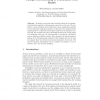Free Online Productivity Tools
i2Speak
i2Symbol
i2OCR
iTex2Img
iWeb2Print
iWeb2Shot
i2Type
iPdf2Split
iPdf2Merge
i2Bopomofo
i2Arabic
i2Style
i2Image
i2PDF
iLatex2Rtf
Sci2ools
ICANN
2003
Springer
2003
Springer
Unsupervised Learning of a Kinematic Arm Model
Abstract. An abstract recurrent neural network trained by an unsupervised method is applied to the kinematic control of a robot arm. The network is a novel extension of the Neural Gas vector quantization method to local principal component analysis. It represents the manifold of the training data by a collection of local linear models. In the kinematic control task, the network learns the relationship between the 6 joint angles of a simulated robot arm, the corresponding 3 end-effector coordinates, and an additional collision variable. After training, the learned approximation of the 10-dimensional manifold of the training data can be used to compute both the forward and inverse kinematics of the arm. The inverse kinematic relationship can be recalled even though it is not a function, but a one-to-many mapping.
| Added | 06 Jul 2010 |
| Updated | 06 Jul 2010 |
| Type | Conference |
| Year | 2003 |
| Where | ICANN |
| Authors | Heiko Hoffmann, Ralf Möller |
Comments (0)

